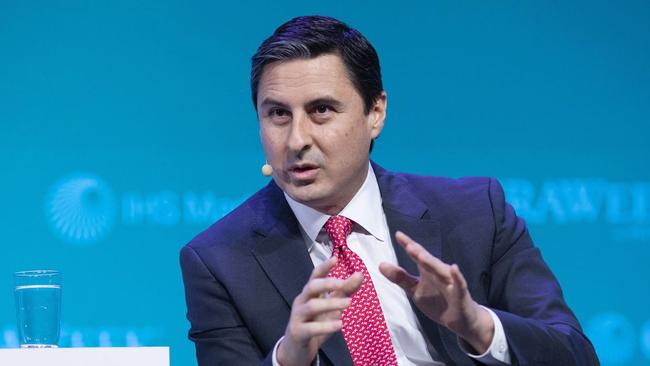Gen X reaches for the top job
At the largest companies, chief executives under 50 are still a rarity. Why?

When he became chief executive of power-generation company NRG Energy more than three years ago, Mauricio Gutierrez says, his selection raised eyebrows. One reason: he is younger than most executives running S&P 500 companies.
“I’m an outlier,” the 48-year-old says. “People take notice.”
At the largest US companies, chief executives under 50 are still a relative rarity. A Wall Street Journal analysis of S&P 500 companies that filed corporate proxy statements by May 1 shows 28 of 493 chief executives, or 6 per cent, are under 50.
Among members of Generation X in the top job: Nasdaq’s Adena Friedman, 49, along with the chiefs of burrito chain Chipotle Mexican Grill and casino giant casino giant Wynn Resorts.
Corporate governance experts have pushed companies to appoint more diverse — and, at times, younger — directors to boards, yet leaders of big companies are still largely baby boomers. The median age of a chief executive in the S&P 500 is 58, the Journal analysis of proxy data from MyLogIQ shows.
Many corporations pick older chief executives because they are seen as battle-tested, while younger executives are still considered a bit of a risk, says Charles Elson, director of the Weinberg Centre for Corporate Governance at the University of Delaware.
“There is something to be said for managerial experience, and you gain that through a long time of putting in the hours,” Elson says.
Chipotle named Brian Niccol, the 45-year-old former chief of Taco Bell, as its chief in February last year as it looked to revive its business after a food-contamination crisis swept across dozens of locations and rocked the confidence of diners and shareholders.
That same month, Wynn Resorts appointed 43-year-old Matt Maddox, the company’s president, to the top job after Steve Wynn resigned as chairman and chief executive following sexual-misconduct allegations.
A Chipotle official, in a statement, says Niccol and his digital expertise bring “fresh energy.”
Wynn chairman Philip Satre in a statement says of Maddox: “Immediately upon taking over as CEO, Matt implemented meaningful changes at all levels.” He adds, “Wynn Resorts has transformed from a founder-led company to a more conventional model of corporate governance.”
Under-50 chief executives say they bring a notable perspective to the job. Many Gen X chiefs worked in senior operating roles, a level or two below the chief executive, during the chaos of the financial crisis when sales began to evaporate, says James Cannon, 48, who was 46 when he was named chief executive of Flir Systems, a maker of thermal-imaging and machine-vision cameras and radar and threat-detection equipment for autonomous vehicles.
Cannon says he still operates according to principles he learned in 2009, when he was president of Stanley Works’ industrial and automotive-repair division and the bottom dropped out of the business. The company later merged with Black & Decker. The experience left a mark.
“Cash matters always,” Cannon says of his mindset, adding that he always operates as if the “market will collapse tomorrow”.
Aside from Facebook’s Mark Zuckerberg, the only other chief executive in the S&P 500 in his 30s is Kimco Realty’s Conor Flynn, 38. Kimco — which has interests in 430 US shopping centres — named Flynn to the top spot when he was 34. He recently told investors that despite changes redrawing the retail landscape, he was positioning Kimco to withstand the vicissitudes of the retail real-estate environment. Kimco’s stock price has outperformed the S&P 500 and is up 25 per cent so far this year.
Executives in rapidly changing fields say there can be value in having seen multiple economic cycles. Joseph Margolis, 58, chief executive of Extra Space Storage Inc, compares running a company with the 10,000 hours of mastery popularised by Malcolm Gladwell, author of the book Outliers, who suggests that those who excel in their fields typically put in that amount of practice.
“It’s a big bet to choose a CEO, and there’s a lot at stake,” Margolis says.
“It’s frequently an easier choice to pick someone who’s had a little more experience.”
The number of S&P 500 chief executives in their 40s has declined during the past decade, according to data provided by corporate research firm Equilar. About 7 per cent of chief executives were younger than 50 at the end of last year, compared with about 16 per cent at the end of 2009, Equilar data shows.
There are some signs of a shift. Last year, the average incoming chief executive at an S&P 500 company was 54, five years younger than in 2017, according to executive search and leadership-advisory firm Spencer Stuart.
Any change in the ranks of chief executives would be prompted by corporate boards because directors select who sits in the corner office.
Organisations such as the California State Teachers’ Retirement Systems are pushing companies to bring directors with fresh perspective to boards. Still, the job requirements of a chief executive are different from those of a director.
“If you have a very homogenous group on the board of directors,” NRG Energy’s Gutierrez says, “you can’t fault them for picking somebody who looks and thinks like them.” Gutierrez, who is rearing a family, says his age helps him relate better to customers and employees, and he is comfortable discussing politically charged topics, social media and television shows.
“I’m not this CEO, almost a demigod, that everyone is afraid of and is sitting in the top office,” he says.
Additional reporting: Theo Francis


